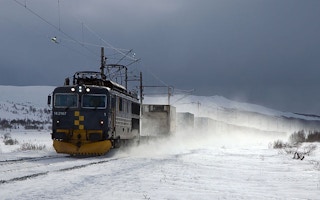Trucks, trains and ships using hydrogen fuel cells for propulsion are no longer just theoretically possible: they have reached the trial stage.
Decades of work on refining the technology have coincided with the need to store surplus energy from solar and wind farms when supply exceeds demand.
And making and storing hydrogen from surplus renewable energy that can then be used as fuel for vehicles is good economic sense, according to the Norwegian research group SINTEF.
Fuel cells are much lighter than batteries and with hydrogen fuel they provide a better method of propulsion for all sorts of freight and passenger transport. The only residue of burning hydrogen is water, so there is no pollution.
“
In Germany, the first fuel cell train is already undergoing trials, and Norway is one of many European countries now considering hydrogen-powered trains.
Steffen Møller-Holst, vice-president for marketing, SINTEF
Going mainstream
Top-secret research and development has been going on since 1980 at SINTEF in an attempt to make fuel cells competitive with the internal combustion engine for transport. The technology is already used in some niche markets, but it is now expected to become mainstream, according to Steffen Møller-Holst, vice-president for marketing at SINTEF.
He says: “In Japan, 150,000 fuel cells have been installed in households to generate power and heat, and in the United States more than 10,000 hydrogen-powered forklifts are operating in warehouses and distribution centres.”
In Norway SINTEF has been working on advancing that technology. Engineers there also want to power forklifts, but they’re planning more: they want as well to power heavy duty trucks and passenger ferries with fuel cells.
Norway is also working on a plan to make its railways greener, running long-distance trains on hydrogen as an alternative to electrifying lines currently operated by diesel locomotives.
“In Germany, the first fuel cell train is already undergoing trials, and Norway is one of many European countries now considering hydrogen-powered trains based on the conclusions of a study carried out by SINTEF for the Norwegian Railway Directorate,” says Møller-Holst. He is convinced Norway should follow the German example.
He recently visited Japan, which is also investing heavily in hydrogen. The reason is that 90 per cent of the country’s energy comes from imported fossil fuels, and to reduce its greenhouse gas emissions it wants to turn to hydrogen. It has signed a contract to start importing hydrogen from Australia in 2020.
The hydrogen truck revolution began in Norway because the country’s largest food wholesaler, ASKO, decided that hydrogen would be more practical than very ponderous batteries. Its first hydrogen-powered lorries will be delivered in 2018.
The project manager, Anders Ødegård, of SINTEF’s department of sustainable energy technology, says: “The use of batteries to power heavy duty trucks would be very expensive.
“They would also be so large and heavy that the trucks’ payload capacity would be considerably reduced. We have to obey the laws of physics and respect material-related constraints.”
Massive savings
This would also apply to trains. In the spring of 2015, Møller-Holst and his colleagues at SINTEF completed a study for Norway’s Railway Directorate, showing that it was possible to operate several of Norway’s rail lines emission-free, including the country’s longest route, the Nordland line, which runs from Trondheim to Bodø, just north of the Arctic Circle.
Surprisingly, the report concluded that between €36 and 45 billion could be saved annually on one section of the line if battery- or hydrogen-powered trains were used instead of the more conventional electric trains drawing power from overhead wires.
Four regions in Germany are currently taking the lead internationally in using hydrogen fuel cells in trains. They have commissioned 100 hydrogen-powered passenger trains, the first of which is already undergoing trials, and the technology is expected to be ready for freight trains before 2025.
SINTEF is working with Statkraft and TrønderEnergi on the construction of Europe’s largest wind farm on a mountain across the fjord from Trondheim. It will produce more energy a lot of the time than can be used locally or absorbed into the grid – which means it can provide the hydrogen to power many of Norway’s trucks, ships and trains.
SINTEF’s enthusiasm for hydrogen is yet another example of what can be achieved by a judicious mix of ingenuity and the prospect of unchecked climate change.
This story was published with permission from Climate News Network.










